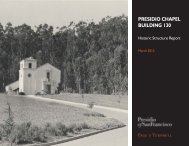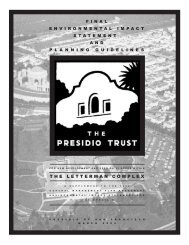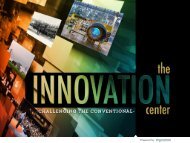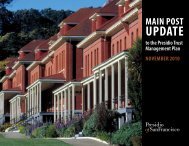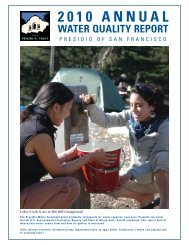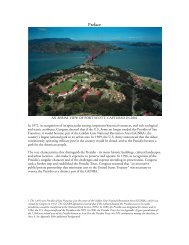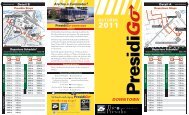Response to Comments - Presidio Trust
Response to Comments - Presidio Trust
Response to Comments - Presidio Trust
You also want an ePaper? Increase the reach of your titles
YUMPU automatically turns print PDFs into web optimized ePapers that Google loves.
TR-31. Estimated Traffic Generated by Former HospitalRPN suggested that applying current trip generation rates <strong>to</strong> the former hospital use results in tripgeneration estimates for the hospital that are unreliable. RPN stated that anecdotal evidence from longtermresidents of the neighborhood calls the hypothetical analysis in<strong>to</strong> question, and speculates that thenursing staff of the hospital would have relied heavily on public transportation in the 1950s <strong>to</strong> 1970s.RPN went on <strong>to</strong> say that “an SEIS should not include such unreliable data as it calls in<strong>to</strong> question theintegrity of the report.” Several individuals agreed, suggesting that the traffic estimated <strong>to</strong> be possiblygenerated by the hospital when it was operational did not reflect actual conditions during that time. Onecommenter noted that from the mid-1960s <strong>to</strong> the mid-1970s, children were able <strong>to</strong> play in the streetwithout concerns of car traffic, which would not be possible with the vehicle trip generation estimated inthe Draft SEIS. Commenters also noted that when the hospital was operational, other conditions affectingthe traffic through the gates were different: 1) cut-through traffic through the PHSH district was muchmore restricted, 2) more people used transit <strong>to</strong> travel <strong>to</strong> and from the project site, and 3) au<strong>to</strong>mobileownership and use were lower than <strong>to</strong>day. The CCSF also suggested that the estimate of traffic thatcould have been generated by the hospital at the project site several years ago is misleading, irrelevant,and likely inaccurate. However, one individual disagreed with the notion, and noted that there were manypeople in the PHSH complex in the World War II era, and that heavy activity in the PHSH district wasnormal in the past.<strong>Response</strong> TR-31 – In 1970, the PHSH had an average monthly inpatient load of 425 and the annualoutpatient visits <strong>to</strong>taled 122,700, for an average daily outpatient load of about 336 patients. The PHSHemployed nearly 1,000 people, including 100 physicians (Thompson 1997). Although translating thislevel of occupancy and activity level <strong>to</strong> trips <strong>to</strong> and from the project site is somewhat speculative, thepatient and staff levels described above suggest that the PHSH district was a bustling area. The estimatesof traffic that would be generated by this level of occupancy is provided only for the purpose ofestablishing his<strong>to</strong>rical context regarding general activity level in the district.TR-32. Traffic Generated by Recent PHSH District UsesThe CCSF requested a better description of recent occupancy (e.g., Chinese-American School and JCC)of the project site and the correlation between those activities and the cited 15 th Avenue Gate traffic countdata.<strong>Response</strong> TR-32 – Tables 8 and 9 below describe the recent occupancy of the project site and trafficcounts at the 15 th Avenue Gate that correlate <strong>to</strong> occupancy of the site by these tenants. Much of the trafficcount data were gathered when the project site was vacant for the purposes of establishing existingconditions prior <strong>to</strong> planning studies for the <strong>Presidio</strong> overall and for the project site. Some traffic datawere collected when the JCC was at the site. The more recent counts include Arion Press, Lone MountainChildren’s Center, and a small amount of office use occupying the upper floor of Building 1806.Public Health Service Hospital <strong>Response</strong> <strong>to</strong> <strong>Comments</strong> 57



